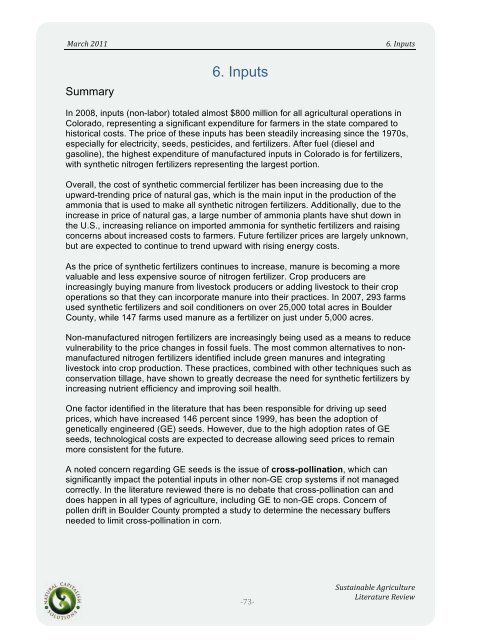Sustainable Agriculture Literature Review - Boulder County
Sustainable Agriculture Literature Review - Boulder County
Sustainable Agriculture Literature Review - Boulder County
You also want an ePaper? Increase the reach of your titles
YUMPU automatically turns print PDFs into web optimized ePapers that Google loves.
! ! !!<br />
"#$%&!'())!! !!!!!!!!!!!!!!!!!!!!!!!!!!!!!!!!!!!!!!!!!!!!!!!!!!!!!!!!!!!!!!!!!!!!!!!!!!!!!!!!!=+!>5?324!<br />
Summary<br />
!<br />
6. Inputs<br />
In 2008, inputs (non-labor) totaled almost $800 million for all agricultural operations in<br />
Colorado, representing a significant expenditure for farmers in the state compared to<br />
historical costs. The price of these inputs has been steadily increasing since the 1970s,<br />
especially for electricity, seeds, pesticides, and fertilizers. After fuel (diesel and<br />
gasoline), the highest expenditure of manufactured inputs in Colorado is for fertilizers,<br />
with synthetic nitrogen fertilizers representing the largest portion.<br />
Overall, the cost of synthetic commercial fertilizer has been increasing due to the<br />
upward-trending price of natural gas, which is the main input in the production of the<br />
ammonia that is used to make all synthetic nitrogen fertilizers. Additionally, due to the<br />
increase in price of natural gas, a large number of ammonia plants have shut down in<br />
the U.S., increasing reliance on imported ammonia for synthetic fertilizers and raising<br />
concerns about increased costs to farmers. Future fertilizer prices are largely unknown,<br />
but are expected to continue to trend upward with rising energy costs.<br />
As the price of synthetic fertilizers continues to increase, manure is becoming a more<br />
valuable and less expensive source of nitrogen fertilizer. Crop producers are<br />
increasingly buying manure from livestock producers or adding livestock to their crop<br />
operations so that they can incorporate manure into their practices. In 2007, 293 farms<br />
used synthetic fertilizers and soil conditioners on over 25,000 total acres in <strong>Boulder</strong><br />
<strong>County</strong>, while 147 farms used manure as a fertilizer on just under 5,000 acres.<br />
Non-manufactured nitrogen fertilizers are increasingly being used as a means to reduce<br />
vulnerability to the price changes in fossil fuels. The most common alternatives to nonmanufactured<br />
nitrogen fertilizers identified include green manures and integrating<br />
livestock into crop production. These practices, combined with other techniques such as<br />
conservation tillage, have shown to greatly decrease the need for synthetic fertilizers by<br />
increasing nutrient efficiency and improving soil health.<br />
One factor identified in the literature that has been responsible for driving up seed<br />
prices, which have increased 146 percent since 1999, has been the adoption of<br />
genetically engineered (GE) seeds. However, due to the high adoption rates of GE<br />
seeds, technological costs are expected to decrease allowing seed prices to remain<br />
more consistent for the future.<br />
A noted concern regarding GE seeds is the issue of cross-pollination, which can<br />
significantly impact the potential inputs in other non-GE crop systems if not managed<br />
correctly. In the literature reviewed there is no debate that cross-pollination can and<br />
does happen in all types of agriculture, including GE to non-GE crops. Concern of<br />
pollen drift in <strong>Boulder</strong> <strong>County</strong> prompted a study to determine the necessary buffers<br />
needed to limit cross-pollination in corn.<br />
"+)"<br />
!,342#.5#6/1!78$.%3/23$1!<br />
9.21$#23$1!:1;.1
















